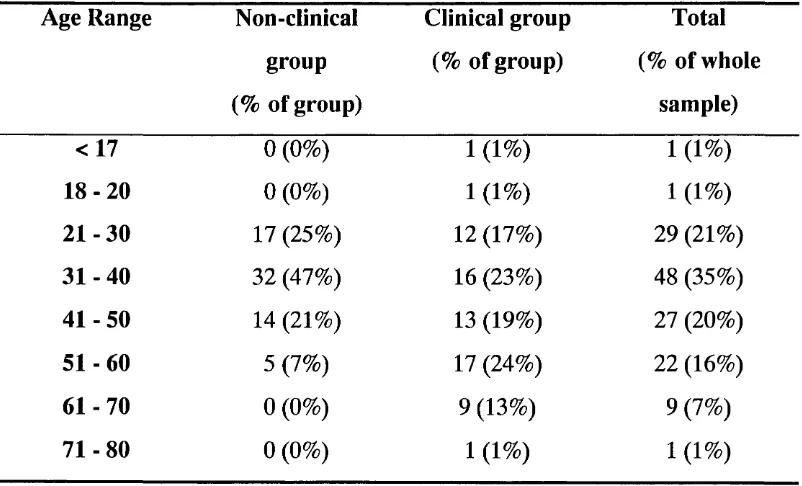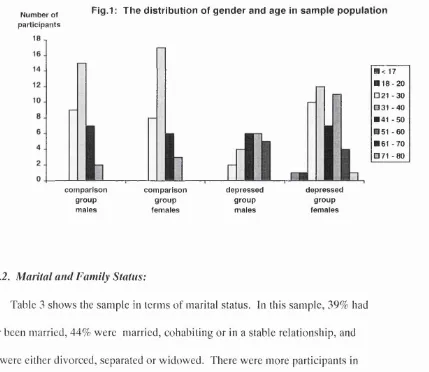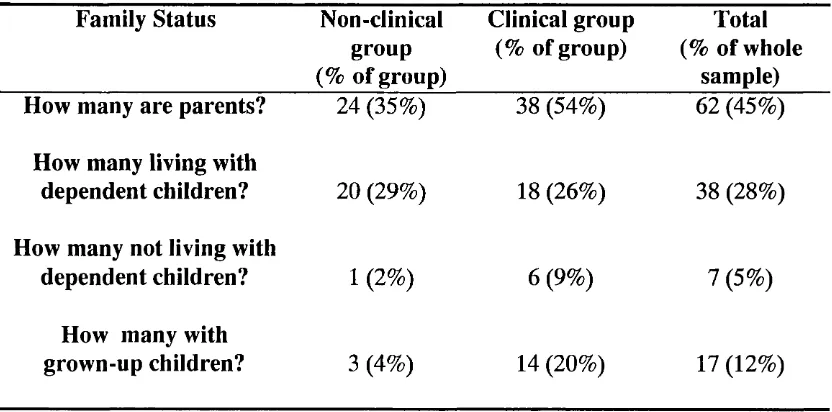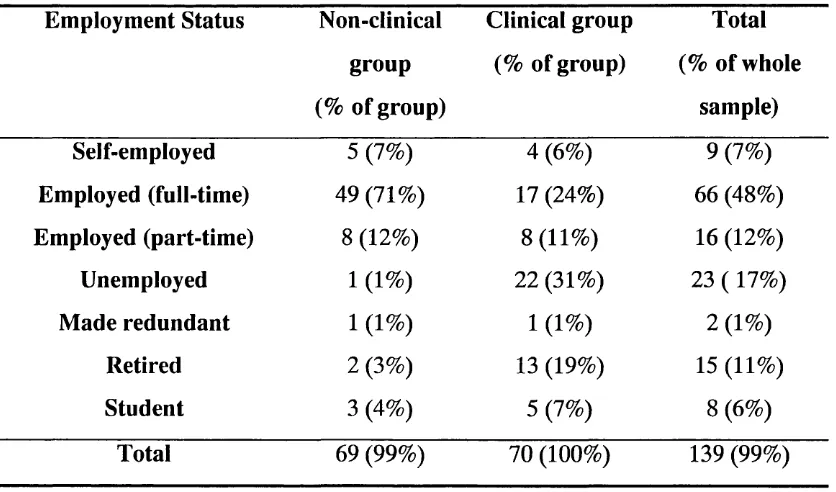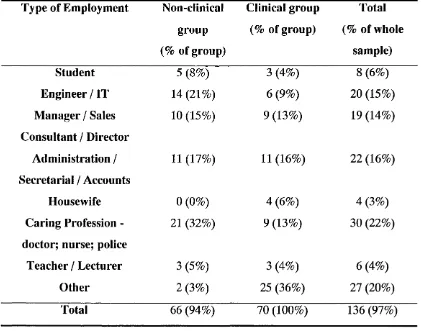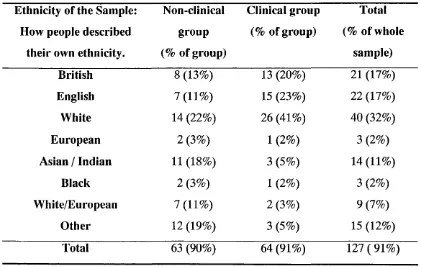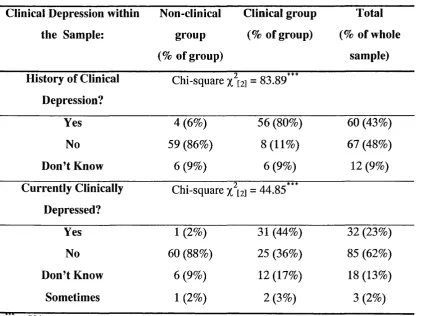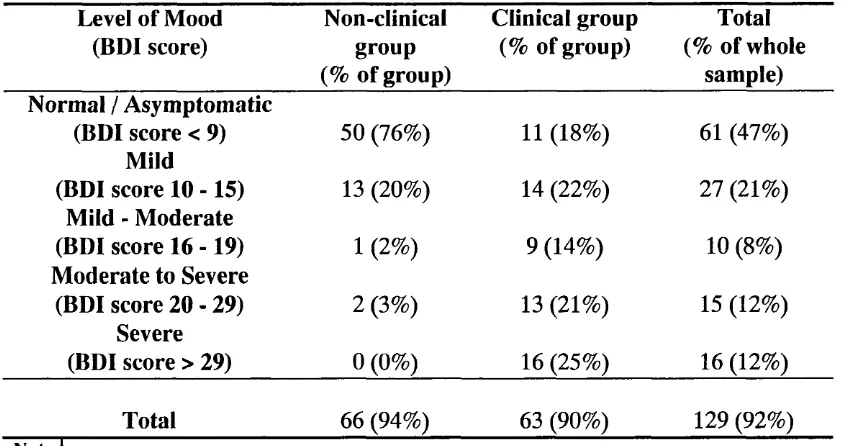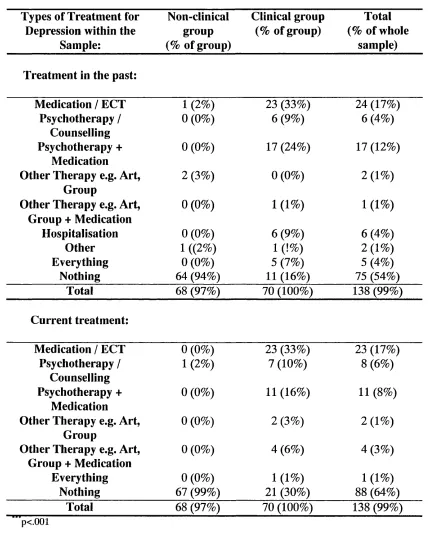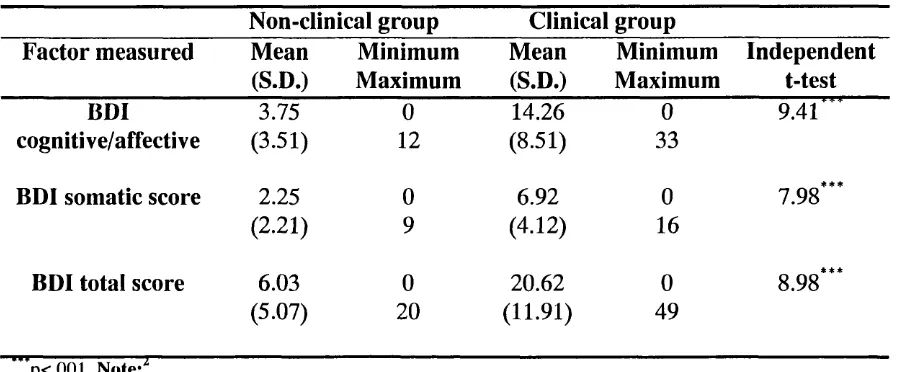Did my parents make me miserable?
Examining the links between parental style, core beliefs and
depression.
Research Thesis
Author:
Rajshree Shah
Date: Is"" May 1998
ProQuest Number: U644186
All rights reserved
INFORMATION TO ALL USERS
The quality of this reproduction is dependent upon the quality of the copy submitted. In the unlikely event that the author did not send a complete manuscript and there are missing pages, these will be noted. Also, if material had to be removed,
a note will indicate the deletion.
uest.
ProQuest U644186
Published by ProQuest LLC(2016). Copyright of the Dissertation is held by the Author. All rights reserved.
This work is protected against unauthorized copying under Title 17, United States Code. Microform Edition © ProQuest LLC.
ProQuest LLC
789 East Eisenhower Parkway P.O. Box 1346
TABLE OF CONTENTS
A C K N O W LE D G E M E N TS... 6
A B STR A C T ... 7
C H A PT E R ONE: IN T R O D U C T IO N :... 8
1.1. Overview of Chapter One... 8
1.2. Introduction... 8
1.3. D epression:... 10
1.3.1. Introduction to Depression...10
1.3.2. Definition of Depression...11
1.3.3. Demographic Characteristics of Depression... 12
1.3.4. Theoretical Models of Depression... 16
1.3.5. Treatment Considerations... 23
1.4. Schemas o r C ore Beliefs:... 28
1.4.1. Introduction to Schemas... 28
1.4.2. Young’s Schema Questionnaire... 30
1.5. P a ren tal Style and B onding:...33
1.5.1. Introduction to Parental Style...33
1.5.2. Bonding versus Attachment... 34
1.5.3. Parental Style and ‘Anomalous Parenting’... 37
1.5.4. Parental Style and Depression...39
1.6. Parental Style, Core Beliefs and Depression... 41
1.7. T he P resent S tu d y :... 44
1.7.1. Proposed Model... 45
1.7.2. Research Questions... 45
C H A P T E R TW O : M E T H O D :... 47
2.1. Overview of Chapter Two... 47
2.2. D esign:... 47
2.2.1. Statistical Power...48
2.3. Selection an d R ecruitm ent o f P a rtic ip a n ts:...48
2.3.1. Sample Size and Response Rates... 48
2.3.2. General Inclusion and Exclusion Criteria for all Participants...49
2.3.3. Selection of Participants for the Clinical Group... 49
2.3.4. Selection of Participants for the Non-Clinical Group... 50
2.4. P ro ced u res:... 51
2.4.1. Ethical Procedures... 51
2.4.2. Administration Procedures... 52
2.4.3. Qualitative and Demographic Information... 53
2.5. M easu res:... 53
2.5.1. Beck Depression Inventory (BDI)... 53
2.5.2. Parental Bonding Instrument (PBI)...54
2.5.3. Young’s Schema Questionnaire (YSQ)... 55
2.6. D ata A nalysis:... 57
2.6.1. Demographic and Psychological Factors... 57
2.6.2. Testing the Proposed M odel...57
C H A P T E R T H R E E : R E SU L T S:...61
3.1. Overview of Chapter Three... 61
3.2. PA R T O N E :... 61
D em ographic an d Psychological C haracteristics of the Sample. 3.2.1. Demographic Characteristics of the Sample...61
3.2.2. Psychological Characteristics of the Sample...70
3.3. PA R T T W O : Application of the Proposed Model to the Clinical Group...80
3.4. PA R T T H R E E : Application of the Proposed Model to the Non-Clinical Group... 92
3.5. PA R T FO U R: 3.5.1. Which Core Beliefs are the Best Predictors of Depression?...102
3.5.2. Conclusions... 104
C H A P T E R FO U R: D ISC U SSIO N :...105
4.1. Overview of Chapter Four...105
4.2. Sum m ary of F in d in gs:...105
4.2.1. Main Findings...105
4.2.2. Hypothesis Testing... 106
4.2.3. Supplementary Findings... I l l 4.3. T he M ain Findings in C o n tex t:...118
4.3.1. Model in Relation to the Clinical Group... 118
4.3.2. Model in Relation to the Non-Clinical Group...119
4.3.3. The Results in Context...121
4.3.4. Good Parents, Bad Parents... 131
4.3.5. Conclusions... 136
4.4. Im plications for Clinical P ractice:... 138
4.4.1. Treatment/Intervention...139
4.4.2. Prevention... 140
4.5. Recommendations for Further Research...140
R E F E R E N C E S :... 143
A PP E N D IC E S:...160
Appendix 1: DSM IV criteria for depression... 161
Appendix 2: Definitions of 16 EMSs...163
Appendix 3: Letters granting ethical approval... 166
Appendix 4: Information sheets for three categories of participants...169
Appendix 5: Consent forms for individual participants...173
Appendix 6: Form for clinicians of outpatient group... 174
Appendix 7; Form for demographic and qualitative information... 175
Appendix 8: Beck Depression Inventory (BDI)...178
Appendix 9; Parental Bonding Instrument (PBI)...180
TABLES:
T able 1: Number of male and female participants in the two groups...62
T able 2: The distribution of age in the two groups:... 62
T able 3: Marital status in the two groups:... 64
T able 4: Family status in the two groups:... 64
T able 5: Employment status in the two groups:... 65
T able 6: Types of employment in the two groups:... 66
T able 7: Table showing how people describe their own ethnicity... 67
T able 8: Table showing how people describe their religious beliefs... 69
T able 9: People’s subjective understanding and experience of “clinical depression” ... 70
T able 10: Categorical analysis of BDI scores... 72
T able 11: Types of treatment for depression experienced by this sample... 74
T able 12: Description of the BDI scores for this sample...75
T able 13: Description of the PBI scores for this sample...76
T able 14: Description of the YSQ scores for this sample... 78
T able 15: Correlations between parental style and depression in the clinical group... 81
T able 16: Regression summary: parental style and depression... 82
T able 17: Correlations between parental style and core beliefs in the clinical group... 84
T able 18: Regression summary: parental style and core beliefs... 86
T able 19: Correlations between core beliefs and depression in the clinical group... 87
T able 20: Regression summary: core beliefs and depression... 88
T able 21: Correlations between parental style and depression in the non-clinical group... 93
T able 22: Correlations between parental style and core beliefs in the non-clinical group... 96
T able 23: Correlations between core beliefs and depression in the non-clinical group... 99
T able 24: The most important core beliefs related to overall depression...103
FIGURES:
Figure 1: The distribution of gender and age in sample population... 63 Figure 2: Proposed model... 80 Figure 3: Proposed model incorporating parental style and
depression link in the clinical group...82
Figure 4: Proposed model incorporating parental style and
core beliefs link in the clinical group...85
Figure 5: Proposed model incorporating core beliefs and
depression link in the clinical group...89
Figure 6: Reminder of the proposed model...92 Figure 7: Proposed model incorporating parental style
and core beliefs link in the non-clinical group...98
Figure 8: Saturated proposed model for the non-clinical group... 100
VOLUME TWO:
CASE REPORTS:
Case Report 1: The case of the client with a dog phobia and the rottweiler...2 Case Report 2: Behavioural problems with a learning disabled woman
diagnosed with cerebella ataxia...15
Case Report 3: Behavioural problems with a pre-school child... 26 Case Report 4: A psychodynamic approach to unresolved
grief in an older adult...37
Service Related Research: Homework compliance as a predictor of outcome
A C K N O W LED G EM EN TS:
I would like to thank my supervisor, Glenn Waller, for his dedication and
support throughout the lifecycle of this project, and beyond. There have been times
when he has amazed me with the speed and accuracy with which he performed this
role. Also, many thanks to Rod Holland and David Olive for facilitating my
applications to Ethics Committees, and to Anne Cooke for her continued support.
I would like to acknowledge the effort that Sue Nokes, co-ordinator of the
London based groups of Depression Alliance, made in facilitating my access to all
the group meetings I was able attend. Thank you too to all the leaders of the groups
who made me feel so welcome, and to all the members for participating in the study.
Thanks to my family for supporting me, leaving me alone in my study and
not making any demands on me. Thanks to Mike for not leaving me alone, and
telling me to have some fun, too. No thanks to the numerous computers and printers
which have gone wrong during the writing of this thesis.
Finally, a very special thank you to my niece, Ursula, who spent hours
laboriously inputting the data with me. She was efficient and fun to work with, I
ABSTRACT:
The relationship between perceived parental style in childhood and depression in
adulthood has been extensively researched over the past two decades since the development
of the Parental Bonding Instrument (Parker, et al., 1979). However, less attention has been
devoted to finding factors that mediate this relationship. Parker (1993) conducted a study
examining for links with personality vulnerability factors, depression and parental style on
depressed participants. Unfortunately, he failed to find links between PBI scores and
depression levels in his sample and so could only speculate on the diathesis-stress model.
The aim of the present study was to test the proposal that the relationship between
parental style and depression is mediated by core beliefs. Young’s (1990) Schema
Questionnaire was used to identify the most relevant core beliefs to depression. There were
70 participants in each of two groups, a clinical and non-clinical group.
For the clinical group, perceived paternal overprotection or control was associated
with depression in adulthood, and this relationship was mediated by the core belief,
vulnerability to harm and illness. For the non-clinical group, there was a relationship
between perceived maternal overprotection and depression in adulthood. This was mediated
by three core beliefs (self-sacrifice, failure to achieve, and social undesirability).
These findings are contrary to conventional wisdom, which regards the relationship
with the maternal figure, and the ‘care’ dimension, as the primary predictors of affective
disorder in adulthood. There is a scarcity of research on men and fatherhood. Therefore,
there is room for speculation about these surprising results. It is suggested that the findings
with the clinical group may suggest abuse, and that in the non-clinical group might reflect
1. CHAPTER ONE : INTRODUCTION
1.1. Overview of Chapter One:
The overall aim of this study is to contribute to a better understanding of the
aetiology of depression, with a particular focus on the role of perceived parental
style. Numerous studies have shown a clear association between parental style and
depression in adulthood (e.g., Blatt & Homman, 1992; Brewin et a i, 1993), but little
is known of the means by which this relationship might be mediated. To redress the
balance, this study pursues the possibility that a particular parenting style affects a
diathesis to depression by inducing a vulnerable cognitive style (rather than by
disposing directly to depression). It investigates the strength of the associations, if
any, between parenting style (as perceived by the depressed person reflecting on
their childhood), core beliefs (or early maladaptive schemas), and depressive
symptomatology. A model is proposed in which the link between parental style and
depression is mediated by core beliefs or schemas, and this model is then
systematically tested.
This introduction will therefore outline the key concepts of depression,
parental style and bonding, and core beliefs (or schemas). The psychological
literature generally, and more specifically the cognitive framework, will be used.
1.2. Introduction:
“I f this feeling o f emptiness, o f something 'without form,
and void', can be deliberately accepted, not denied, then
perception, a sense o f the world reborn. ” (Milner, 1959, cited in
Formaini 1991, pp 38).
It is generally appreciated that in order to accept, one must possess an
understanding of that which is being accepted - making an informed choice.
Psychology is about understanding and treating people, and involves communicating
effectively about emotional distress and coping. Maybe the most important element
in the profession is not imparting “ truth” to patients, but facilitating their journey in
making sense of their experiences. This concept adds a new dimension to the
traditional expert-patient relationship, and renders it much more ambiguous.
The balance between holding and sharing generally available information
regarding a particular psychopathology and adopting an individually tailored
approach with each client is difficult to strike, but is important. The difficulty is
further enhanced when the language is shared between lay and professional persons,
but the meaning is not. For example, everyone probably has some idea of what
depression, or parental style, or core beliefs mean or could mean. Also, most people,
professional and lay alike, assume that there is a link between a child’s upbringing
and how they are emotionally as adults. Kuyken et al. (1992) suggest that there are
more similarities than differences in lay and professional theories of depression.
Their data suggest that depressed patients and non-depressed lay persons have
relatively extensive beliefs about the causes of depression. These beliefs do not only
arise from personal experience (participants had knowledge about things of which
they had no first-hand experience), and they are comparable to those held by clinical
facilitate the aim of this study - to gain a better understanding of the aetiology of
depression.
Prior to examining the relationship between parental style and depression in
detail, it seems logical to outline the main phenomena pertinent in this study. The
next section will provide an account of depression, drawn from the abundance of
available literature.
1.3. Depression:
This section will introduce the concept of depression, and consider ways of
defining this construct. After a resume of its demographic characteristics, three
theoretical models of depression will be presented - medical, psychoanalytical and
cognitive - with the greatest emphasis on cognitive theory, as this forms the basis of
this study. Finally, there will be a summary of treatments for depression. This will
highlight obstacles to successful intervention and the need for developing alternative
forms of treatment.
1.3.1. Introduction to Depression:
Clinical depression is so widespread that it has been called the ‘common cold
of psychiatry’ (Seligman, 1975). As such, it is not surprising that there is a copious
literature on the subject of depression, attempting to understand and treat this
debilitating condition. It has been found to affect numerous individuals across all
age, class, gender and ethnic boundaries. However, the psychiatric literature is
complicated by the variety of meanings attached to the term “ depression” . Angold
framework, combining the various viewpoints and dimensions in the literature to
date:
1. Depression as a description of the low end of the ordinary fluctuations of normal
mood.
2. Depression as a description of the unhappiness, sadness or psychic pain felt as a
response to some unpleasant situation or event.
3. Depression as a trait.
4. Depression as an individual symptom.
5. Depression as a syndrome.
6. Depression as a disorder.
7. Depression as a disease.
8. Cause of handicap.
Angold (1988) notes that this system distinguishes: normal states from
abnormal ones; “ elemental” phenomena (e.g., mood disturbance) from “ compound”
uses (e.g., biological, cognitive and behavioural concomitants); and depression as a
state, trait or reaction. Obviously, these categories are not mutually exclusive, and
some are more established than others. However, they do provide a useful
framework to organise the information available in the psychological literature on
depression. A more formal definition is found in the Diagnostic and Statistical
Manual of Mental Disorders (DSM-IV, American Psychiatric Association, 1994).
1.3.2. Definition o f Depression:
According to DSM-IV (American Psychiatric Association, 1994), the
common symptoms of depression include: loss of motivation, sadness, anhedonia,
The common symptoms of mania (the opposite of depression) are: greatly increased
energy, racing thoughts, pressured speech, wild and extravagant behaviours, and
grandiosity. The majority of people who suffer from depression never experience
mania, but people who suffer from manic episodes typically also have depressive
episodes. Hence, these affective disorders are categorised into bipolar affective
disorder and unipolar depression. This study is mainly concerned with the more
common unipolar depression, although anecdotal information about the bipolar
condition was collected. The DSM-IV divides unipolar depression into major depressive disorder (MOD - one or more episode of severe depressive symptoms for a period of two weeks or more) and dysthymic disorder (DD - which is characterised by a chronic experience of moderate to severe depressive symptoms, lasting for at
least a two year period). Although the usefulness of such diagnostic criteria is
currently being debated, this seems to be a necessary framework for a term that has
meaning both at a professional and at a lay person’s level.
1.3,3. Demographic Characteristics o f Depression.
Klerman (1988) has written a thought-provoking paper, speculating on the
increase in depression over the last 30-40 years. He reminds readers of the dynamic
and temporal nature of conditions by discussing aspects such as age, period and
cohort effects. He reports that the conventional wisdom has been that depression
increases with age, and explains how this has intuitive “ face validity” . As
individuals grow older, they experience more loss: the deaths of relatives, friends and
other important persons; children grow up, become independent and move away.
With age, there is increased likelihood of medical illness, infirmity and disability.
and perhaps more significantly, the elderly individuals anticipate their own death and
the awareness of human mortality increases. In his meta-analysis, however, Klerman
finds that the conventional wisdom is supported only by data collected in surveys.
When clinical diagnoses with structured interviewing techniques are used, there is no
increase in prevalence of depression with age. In fact, the highest prevalence of
depressive disorder is found to occur among young adults.
Having established that there has been an overall increase in depression and
that there is an earlier age of onset, Klerman (1988) suggests that some form of
period or cohort effect must be operating. He concludes that coming to maturity in
the period 1960 - 1975 seems to have had an impact on the likelihood of depressive
illness. Brodaty et a l (1997) also examined depression across ages, and found
apparently robust phenomenological differences in depression between older and
younger participants. They suggest that their study might aid in understanding the
neurobiology of depression.
Parker et a i (1995) suggest that low parental care should be in the established
list of major risk factors (such as female sex, younger age and divorce / separation).
They did however, suggest that these may be predisposing factors to a variety of
psychiatric disorders, and not specifically to major depression. Richards et a l (1997)
conclude that divorce and separation have a long-term and specific impact on mental
health, particularly depression, anxiety and alcohol abuse. Rodgers (1994) reported
that women who had divorced had high levels of depression, but only among those
whose parents had divorced. Pathways between parental divorce and own divorce
are likely to be complex, and may interact with social causation factors.
depression in adulthood (Rutter and Madge, 1976). However, the combination of
these psychological and sociological factors is no better demonstrated than when
considering gender issues in adulthood depression. Therefore, the next section has
been devoted to do this in some detail.
13.3.1. Gender issues in depression:
With respect to gender, there is substantial evidence from various sources to
suggest that females show higher lifetime prevalence than males (e.g., Weissman and
Klerman, 1977). However, there is some suggestion that the gender ratios may have
been narrowing in recent years (Murphy and Wetzel, 1980; Rice el a i, 1984).
Nolen-Hoeksema (1987) offers one possible explanation for this gender difference,
suggesting that men have adopted a more adaptive response (engage in distracting
behaviours that dampen their mood when depressed) than women (who ruminate
about their depressed states and their possible causes, hence amplifying their moods).
She identifies four gender differences which have implications in clinical practice:
• sex role demands might prevent a seriously depressed man from seeking the help
he needs;
• sex role expectations of women might encourage them to pay too much attention
to their own hedonics;
• seriously depressed women may be more likely to be detected than seriously
depressed men;
• mildly depressed women may be more likely to become moderately or severely
depressed.
Conversely, Phillips (1993) voiced the concern that boys often fail to learn a
for anyone to make sense of what it is they feel. Indeed, the very words that are used
to talk about feelings are dominated by female metaphors. For example, words like
“ thrusting” and “ incisive” suggest masculinity, while “ empty” , “ drained” or “ full”
are words with gender-specific connotations suggesting feminine containment
(Thomas, 1996). Brown et a l (1988) studied depression in women, and suggested
that those most likely to benefit from cognitive therapy are in the subgroup who get
into the habit of depression, and need a jolt to get a more positive perspective on
life.
In her comprehensive resume of sex differences in unipolar depression,
Nolen-Hoeksema (1987) notes that the failure to find gender differences in some
studies may be because goals and lifestyles of male and female college students are
more likely to be similar than in non-student populations. Indeed, twelve out of a
possible twenty relevant studies viewed in a literature search used college samples.
For example, Hammen and Padesky (1977) failed to find significant gender
differences on BDI scores when they asked over 2,000 students to complete the self-
report questionnaires. However, the men in the depressed subsample were
statistically distinguishable from depressed women by a combination of items that
included an inability to cry, loss of interest in other people, a sense of failure, and a
variety of somatic responses. Women were characterised by indecisiveness and self
dislike. A more recent study by Gjerde (1995) found that a mostly allocentric
(undersocialisation and interpersonal antagonism) mode of behaviour anticipates
chronic depressive symptoms in young men, whereas a mostly autocentric
(oversocialisation and introspective concern with self) mode of behaviour anticipates
Most studies consider gender as an adjunct to their main area of interest, but
Sowa and Lustman (1984) conducted a study investigating gender differences
specifically. They found that men reported experiencing a significantly greater
number of stressful life changes, but women perceived their stressors as more severe.
They found a gender variation in the relationship between cognitive distortion and
depression. Men reported significantly less depression than women, while
simultaneously expressing higher levels of cognitive distortion. In contrast, levels of
cognitive distortion for women were three times more powerful in predicting
depressive mood. They suggest that Beck’s (1974) aetiological model, in which
cognitive distortions are involved in the development and maintenance of depression,
is most applicable to female depression. Also, Scott et al. (1988) reported a
significantly higher incidence of unipolar depression in families of female chronic
depressives, and suggest that this finding may mean that chronic depression has
differing aetiologies in males and females. It is apparent that there are various ways
of conceptualising gender differences in depression. However, the evidence seems to
suggest that there are qualitative differences in depression among men and women, a
point worth noting in clinical practice.
1.3.4. Theoretical Models o f Depression:
The main schools of thought to date have been:
• Medical model
• Psychoanalytic model
1.3.4.1. The Medical Model:
The medical model suggests an imbalance in brain chemistry. Medication is
the standard treatment for depression. The patient information leaflet with each
packet of paroxetine (“ Seroxat” ), one of the new class of antidepressants, contains
the reminder that “ Depression is a common illness; It is nothing to be ashamed of. It
is not a sign of weakness. It can be treated successfully.” It explains the latest
understanding of the biochemical aetiology of depression very simply: “ Everyone
has a substance called serotonin in their body. Low levels of serotonin in the brain
are thought to be a cause of depression and other related conditions. ‘Seroxat’ is one
of a group of medicines called selective serotonin reuptake inhibitor (SSRI)
antidepressants and works by bringing the levels of serotonin back to normal.”
However, there are compelling reasons why medication might not be the
preferred form of treatment for some individuals. Firstly, antidepressants produce
side-effects which reduce compliance (Hollon, 1981). Secondly, a proportion of
patients do not respond, and some refuse drug treatments altogether. Finally, there is
some evidence to suggest that a combination treatment of medication and
psychotherapy is optimally effective (Bowers, 1990). Lam et al. (1997) have shown
that dysfunctional attitudes impair spontaneous recovery from depression, and that
the effects of antidepressant drug treatment may obscure this effect. They conclude
that recovery from depression may include a complex mixture of biological and
psychological pathways.
1.3.4.2. The Psychoanalytic Model:
The psychoanalytic literature is unanimous in regarding melancholic
“ internal object” and not necessarily an actual person. For example, Freud (1917)
suggested that “ in melancholia, the occasions which give rise to the illness extend for
the most part beyond the clear case of a loss by death, and include all those situations
of being slighted, neglected or disappointed, which can import opposed feelings of
love and hate into the relationship or reinforce an already existing ambivalence” (pp
251). The psychoanalytic view suggests that the internal object is ambivalently
invested. Therefore, the depressed person feels dependent on the same object to
which he or she is none the less hostile. Redder (1982; cited in Brown & Redder,
1991), for example, moved Freud’s idea beyond relationships with other people, to
include situations in the environment: “ Depression, for example may follow failure
to achieve some longed for ambition or position vital to self-esteem” (pp 23). In
depression, he or she imagines having destroyed this object (hence the self-reproach),
but is incapable of surviving without it (hence the depression). This view of
depression assumes that, even in health, these people are subject to a state of
precarious balance, since their stability is based on a complex, ambivalent
relationship towards an internal object.
To review these models in depth is beyond the scope of this study, but both
the medical and the psychoanalytical models suggest that the condition of depression
is very much out of the control of the individual - this is the way they are,
predisposed to depression. The interventions - medication or long-term therapy -
based on these models reflect this concept. They suggest that a person can only
move out of a depressed episode with extensive external, professional help.
However, this idea could be construed as colluding with intense feelings of being out
contrasted with the cognitive model, with its emphasis on developing internalised
skills of control.
13.4.3. The Cognitive Model:
Over two decades ago, the empirical literature on neurotic, exogenous
depression was dominated by studies addressing Beck’s (1967,1974) cognitive
theory, Seligman’s (1974, 1975) learned helplessness model, or Lewinsohn’s (1974)
theory, attributing depressive states to a low rate of response-contingent positive
reinforcement. The essence of Beck’s theory is that the root of depression is a
negative cognitive set. The depressed person is seen as having a negative view of
him or herself, of the world, and of the future - the cognitive triad. The affective
state of depression is said to be secondary to these negative cognitions. Although the
theory recognises that an episode of depression may be externally precipitated, it is
the individual’s perception and appraisal of the event that render it depression
inducing. This concept is in sharp contrast to those of the medical and
psychoanalytic models, in apportioning much of the responsibility onto the
individual themself. Since its presentation, this theory has been the centre of much
research, for example, in the field of information processing, and forms the basis of
much clinical practice.
Seligman’s (1974,1975) views on depression are rooted in laboratory
experiments with dogs. He showed that the prior experience with uncontrollable,
noxious stimulation is said to result in learned helplessness. This condition is
manifested in a motivational deficit, and in an interference with the learning of new
response-relief contingencies. The helpless animal is said to have learned that
humans suggesting that reactive depression is essentially a state of learned
helplessness, characterised by the perception of lack of control. Since then, research
dedicated to investigating loci of control have converged with this theory. These
concepts are used extensively in management training.
Lewinsohn (1974) was a behaviourist. He proposed that a person’s
depression is due to their low rate of response-contingent positive reinforcement.
This low rate may exist for several reasons. It may be that few events are
reinforcing, or perhaps few reinforcing events are available in the person’s immediate
environment. The individual may lack the skills necessary to make responses that
are likely to be reinforced. Lewinsohn is explicit in claiming that it is not the rate of
reinforcement per se but the rate of response-contingent positive reinforcement that
is crucial. This again incorporates the idea of the person having (or lacking) some
control over their environment.
Blaney (1977) wrote a comprehensive comparison of these theories, and
concluded that there was considerable overlap among the theoretical positions.
Together, they suggest the importance of three variables in depression - perception,
control and rate. He notes that the ideas of these three theorists have generated much
research interest, and highlights two alternative theories which he suggested deserve
equal attention. The first is rooted in the common observation that depressive
conditions often appear to have an intropunitive quality. Forrest and Hokanson
(1975) hypothesised that “ one component of depression may be related to the
instrumental value that depressive, self-demeaning displays have in controlling
aversiveness and threat from others.” In this view, depressives distort reality in a
perceptions and judgements. There is a conflict in the depression literature about the
role of distortion, highlighting fundamental questions about who distorts, what
information is distorted, and to what end. Albright and Henderson (1995) addressed
this issue, and concluded that negative distortion, not realism, is characteristic of
even mildly depressed subjects.
The second theory was presented by Coyne (1976). A sequence is presumed
to occur when an individual undergoes a stressful experience. The experience
renders the person in special need of support and validation from other people, and
the depressive symptoms that emerge are designed to solicit that support. When it is
forthcoming, however, the individual may doubt its sincerity and request more
reassurance. Such persistent demands may be “ aversive to members of their social
environment,” but “ accompanying indication of distress and suffering is powerful in
its ability to arouse guilt in others and to inhibit any direct expression of annoyance
or hostility from them” . The depressed individual may be somewhat aware of the
annoyance, however, leading him to be even more needy and persistent in emitting
the instrumental symptoms. Joiner el a l (1992) tested Coyne’s theory in college
students, and found that it was the combination of depression, reassurance seeking,
and low self-esteem which placed participants at greatest risk of rejection. There
were significant gender differences, in that these effects were obtained for males
only.
These two models conclude that certain depressive symptoms are
instrumental behaviours that are maintained by their consequences. This is opposed
to the suggestion that depressive symptoms are caused by the real or perceived
specifically that the skills whose lack leads to depression are the very skills one
needs when one has experienced stress and needs support from others (e.g., ability to
elicit support without also eliciting hostility). Furthermore, Birtchnell et a l (1991)
explored the relationship between depression and dependence and concluded that,
although there is a direct linear relationship between neuroticism and level of current
depressive symptoms (Katz and McGuffin, 1987), neuroticism is more intrapersonal
and dependence is more interpersonal.
These models paint a bleak picture for individuals suffering from depression.
Perhaps one way forward would be to examine the roots of the lack of social skills
that is characteristic of depressed people. Indeed, one of the recent criticisms of the
cognitive approach has been of its focus on the here-and-now (with scant regard for
the personal history of the client). The need for integrating Beck’s cognitive model
with developmental theory has recently been identified. Leahy (1995) has made a
persuasive case for choosing Piaget’s structural and Bowlby’s object representations’
developmental models with which to integrate Beck’s cognitive model, to understand
the primitivism and resistance of early core beliefs (schemas).
The present study also aims to redress the balance, giving an understanding of
the development of a person’s depression in the light of experiences with parental
figures in childhood. The section on schemas or core beliefs shows how cognitive
theory has responded to the need for a more integrated approach (Beck, 1991). In the
next section, a broad overview of therapeutic interventions will be presented,
1.3.5. Treatment Considerations:
The vast majority of depressed individuals suffer from illness episodes which
either spontaneously remit or respond to one of the many forms of treatment now
available (Hawton et a l, 1989). Drugs remain the standard treatment. However,
Hollon (1981) reported drop-out rates ranging from 20% - 50%, and suggested that
estimates of drug-response may be inflated by proportionately more non-responders
dropping out of trials. There are compelling reasons why a psychological treatment
might be preferable in some instances. Many antidepressants produce side-effects
which reduce compliance. A proportion of patients do not respond, and some refuse
drug treatments altogether. Indeed, drugs are a major problem in overdose and the
hazards of chronic use are not well documented. There is also evidence to suggest
that cognitive psychotherapy may even have a greater relapse prevention effect than
short-term antidepressant medication (Blackburn et a l, 1986; Rush et a l, 1977).
However, when considering outcome of interventions, it is important to bear
in mind the “ quality of the clinical population” . Most of the outcome studies
comparing Beck’s cognitive therapy with antidepressant medication have attempted
to find markers which might predict good or poor response. These can be divided
into three broad categories:
1. Factors related to the illness: Studies of cognitive therapy have tended to show
that measures of severity and length of illness are related to poor prognosis.
2. Premorbid characteristics o f the patients: Patients with personality disorders do
not always respond well to cognitive therapy. Although it is extremely difficult to
research this area (mainly because it is very difficult to diagnose a person with a
with the collaborative relationship can cause problems in therapy. Also, the rather
vague construct of “ psychological-mindedness” seems to be a relevant personality
trait in predicting outcome of cognitive therapy.
3. Cognitive factors: Hopelessness, negative thoughts, cognitive distortions and
maladaptive assumptions all proved to be closely correlated with therapy in their own
right. The extent to which patients used cognitive coping strategies is also a relevant
factor in predicting outcome of therapy. The patient’s familiarity with the strategies
involved in the intervention would obviously facilitate the process of therapy.
Fennell and Teasdale (1987) concluded that “ the important characteristic of
those who improved rapidly was that they readily accepted the conceptualisation
offered and that this was then ‘validated’ by evidence from their homework
assignments.” In 1989, Moorey concluded that the present state of knowledge would
suggest that cognitive therapists are advised to concentrate on working with patients
who have a relatively acute depression, have a stable premorbid personality and, at
assessment, are able to see some relevance of the cognitive model to their depression.
However, it is often chronic patients, who have failed to respond to other
treatments, who are referred for cognitive therapy. Robins and Guze (1972)
reviewed 20 follow-up studies of affective disorders, and reported an average
incidence of 12-15% of “ chronic course” cases. Chronic depression affects a large
number of individuals. Unfortunately, the clinical stereotype depicting all chronic
depressives as suffering from a character-based disorder still persists, and often leads
to inappropriate or inadequate treatment of their illness (Weissman and Klerman,
discover the cognitive factors associated with clinical outcome, this poses a problem
for treating this client group.
Much of cognitive therapy relies on modifying beliefs through the review or
production of evidence that contradicts negative or maladaptive conclusions drawn
by a client (Padesky 1994; Young 1990). With problems of relatively short duration,
production of contradictory evidence often leads to a shift in belief. This shift in
belief can occur quickly if supporting alternative beliefs (or schemas) exist. Thus, a
depressed person who currently has an “ I am bad” self-schema activated, may be
able to shift this belief within a few weeks if this person also has an “ I ’m OK”
schema (which is normally activated in the non-depressed state). However, people
with lifelong or chronic depressive problems often do not have an alternative belief
(schema) available, and therefore contradictory evidence is far less likely to shift
their beliefs. For this reason, treatment of chronic problems within cognitive therapy
usually involves not only testing maladaptive beliefs but also identifying and
strengthening alternative, more adaptive schemas. An alternative schema must be
developed before the client will be capable of accepting the evidence. Therefore,
therapy for this client group has dual goals of weakening maladaptive schemas and
developing more adaptive ones.
A number of authors have discussed how cognitive therapy can be modified
and refined to address the cogent theoretical criticisms of Mahoney (1980), Coyne
and Gotlib (1983) and others. They draw upon the evidence from clinical challenges
posed by patients who do not respond adequately to standard cognitive therapy.
depression for such patients by highlighting the necessary conditions for successful
therapy:
1. Patients have access to feelings, thoughts and images with brief training.
2. The patient has identifiable problems on which to focus.
3. The patient has motivation to do homework assignments and learn self-control
strategies.
4. The patient can engage in a collaborative relationship with the therapist within a
few sessions.
5. Difficulties in the therapeutic relationship are not a major problem focus.
6. All cognitions and behaviour patterns can be changed through empirical analysis,
logical discourse, experimentation, gradual steps, and practice.
It is not difficult to see how individuals with personality or character-based
disorders violate these basic assumptions. Therefore, Robins and Hayes (1995) have
identified some of the recent developments that have occurred in cognitive therapy
which include:
• a distinction between “ core” and more “ peripheral” schemas
• an appreciation of the role of defensive processes in the avoidance of schema-
related material
• a greater emphasis on exploration of the therapeutic relationship and on the
patient’s interpersonal relationships in general
• a greater emphasis on the role of affective arousal for the elicitation and
modification of schemas
• a greater emphasis on exploration of developmental experiences that may have
Some of these developments have borrowed theoretical concepts or
techniques from other therapeutic approaches (e.g., ‘internalising a problem’, or
projection, or introjection). However, since a conceptual framework that emphasises
the role of dysfunctional schemas is retained, these developments can best be viewed
as an evolution in the sophistication of the cognitive therapy model itself, rather than
a new form of psychotherapy. Indeed, Beck described these aspects in his earlier
writings, but they were not emphasised then. Researchers and scholars in other
theoretical approaches have also begun to look to cognitive psychology and cognitive
therapy for a language to re-describe or develop psychodynamic and other
approaches (e.g.. Beck, 1991; Gilbert, 1984). Bowlby (1977), with his background
in the psychoanalytic school of thought suggested: “ By framing the processes in
terms of cognitive psychology, I believe, much greater precision becomes possible
and hypotheses regarding the causative role of different sorts of childhood
experiences, through the persistence of representational models of attachment figures
and self at an unconscious level, can be formulated in testable form.”
Therefore, the literature suggests that it is mainly individuals suffering from
chronic depression (usually women) who reach psychological services. The
stereotypic belief about the personalities of these patients persists in the clinical
setting (maybe becoming more generous by alluding to features of personality
disorder). Finally, the need remains paramount to establish short term therapy that is
effective for political and financial reasons. Therefore, perhaps the obvious source of
information is in the developments that have been made in the cognitive treatment of
(1990) conceptualisations with regard to treating people with chronic psychological
distress.
1.4. Schemas or Core Beliefs:
This section will define the key concept in cognitive therapy pertinent to this
study - schemas or core beliefs - and introduce the instrument recently designed to
identify sixteen of these schemas, Young’s Schema Questionnaire.
1.4.1. Introduction to Schemas:
Beck introduced the concept of the schema to cognitive theory as early as
1967, defining it as “ a structure for screening, coding, and evaluating the stimuli that
impinge on the organism. It is the mode by which the environment is broken down
and organised into its psychologically relevant facets. On the basis of schemas, the
individual is able to ... categorise and interpret his experiences in a meaningful
way” . This idea is based on information processing theory, which posits that
schemas develop as part of normal cognitive development. Segal (1988) offers an
alternative definition of schemas, based on a consensus of many researchers:
“ organised elements of past reactions and experience that form a relatively cohesive
and persistent body of knowledge capable of guiding subsequent perception and
appraisals” . Segal goes on to contrast several different models of schemas which
offer differing explanations regarding (a) the relationship between moods and
personal construct, and (b) the interconnectedness of personal constructs within the
self-system.
In 1990, Beck and his colleagues were differentiating between core beliefs
they would discover the “ real me” and would reject m e’). The various terms used to
describe critical constructs in cognitive theory and practice are:
• core beliefs, schemas or schemata (these terms are interchangeable).
• conditional beliefs or underlying dysfunctional assumptions.
• automatic thoughts or negative automatic thoughts (NATs) - cognitions that
automatically and temporarily flow through one’s mind.
Core beliefs and conditional beliefs are relatively similar, in that they are both
deeper cognitive structures than automatic thoughts. However, different therapeutic
processes are used to evaluate and change these two types of beliefs. Padesky (1994)
describes a clinical procedure designed to identify and alter the maladaptive core
beliefs of clients.
Schema-focused cognitive therapy is concerned with alleviating symptoms of
distress through the modification of underlying maladaptive cognitive structures or
schemas (e.g., Padesky, 1994; Young, 1990). As such, it is regarded as a truly
integrative approach, which includes exploration of the early childhood origins of
client’s problems, the interpersonal aspects of the therapy relationship, and the
utilisation of imagery and other experiential techniques in both assessment and
treatment (Bricker et a l, 1993). The theory suggests that early maladaptive schemas
(EMSs) create distress through cognitive biases, which result in the dysfunctional
synthesis of environmental and intrapersonal data (Schmidt et a l, 1995). Once
formed, EMSs are maintained in the face of contradictory evidence through the
processes of distorting, not noticing, and discounting contradictory information, or
by seeing this information as an exception to the schematic (and therefore,
component in cognitive therapy. In the next section, the reasoning behind the
development of Young’s Schema Questionnaire will be explored, highlighting the
direction in which Beck’s conceptualisations have progressed,
1.4.2. Young*s Schema Questionnaire:
Young (1990) expands the model on which short-term cognitive therapy for
depression is based by incorporating four theoretical constructs - Early Maladaptive
Schemas (EMS), Schema Maintenance, Schema Avoidance, and Schema
Compensation. He offers a straightforward working theory which patients can
understand, and which enables patients and therapists to communicate about deeper
level phenomena. Although he discusses schemas as if they exist structurally, he
acknowledges that they are indeed hypothetical constructs, designed to facilitate
communication. Only EMSs will be discussed here, as they are most pertinent to this
study. The other constructs have been described as more pertinent to the personality
disorders.
Young (1990) proposed a primary emphasis on the deepest level of cognition
- core beliefs or Early Maladaptive Schemas (EMSs). EMSs are the cognitive
representations of stable and enduring themes that develop during childhood, and are
elaborated upon throughout an individual’s lifetime. These schemas serve as
templates for the processing of later experience. Young identifies six defining
features of EMSs:
• Most EMSs are unconditional beliefs about oneself in relation to the environment.
• EMSs are self-perpetuating, and therefore much more resistant to change than
NATs or dysfunctional assumptions.
• EMSs are usually activated by events in the environment relevant to that schema.
• EMSs are closely tied to high levels of affect when activated.
• EMSs seem to be the result of dysfunctional experiences with parents, siblings,
and peers during the first few years of an individual’s life.
''Significant experiences o f early life may never recur, but their effects remain
and leave their m a r k ... they are registered as memories, a permanent trace
and an embedded internal stimulus ... Once registered, the ejfects o f the past
are indelible, incessant and inescapable. ...The residuals o f the past do more
than passively contribute their share to the p r e s e n t... they guide, shape or
distort the character o f current events. N ot only are they ever present, then,
but they operate insidiously to transform new stimulus experiences in line
with past. ” (Millon 1981, pp 101).
Although schemas play a central role in cognitive conceptualisations of
personality disorder and increasingly in other disorders, research devoted to the
assessment of schemas has been scarce. The development of the Schema
Questionnaire (Young, 1990) has enabled the identification of sixteen EMSs, which
are relevant to many longer term patients in clinical practice. Each schema can have
many variations on the same theme, and most chronic patients with functional
disorders have more than one of these core schemas. They are grouped into five
broad categories, which correspond to general areas of functioning:
• Impaired Autonomy - Functional Dependence/Incompetence;
Subjugation; Vulnerability to Harm and Illness; Enmeshment.
• Disconnection - Emotional Deprivation; Abandonment; Mistrust/Abuse;
• Undesirability - Defectiveness/Shame; Social Undesirability; Failure to
Achieve.
• Restricted Self-Expression - Emotional Inhibition; Self-Sacrifice;
Unrelenting Standards.
• Insufficient Limits - Entitlement; Insufficient Self-Control/Self-
Discipline.
Appendix 1 has a list of full definitions of all the sixteen core schemas listed
above. Young’s Schema Questionnaire (YSQ) has been shown to possess
convergent and discriminant validity with respect to measures of psychological
distress, self-esteem, cognitive vulnerability for depression and personality disorder
symptoms (Schmidt et a l, 1995). It is a relatively new clinical instrument, long and
therefore difficult to administer for research purposes, but it was used in the present
study because the information it yields regarding individuals in psychological
distress is potentially valuable. There are no other instruments designed to identify
the core beliefs of people, and therefore the YSQ deserves consideration.
The case has been made that one should consider the role of core beliefs in
the psychopathology of depression. However, it is also important to consider the
origins of those core beliefs. According to Young’s (1990) model, a strong
contender for this role must be parental style, since so many of his descriptions of
EMSs involve a causal role for caretaking style in childhood. In the next section, the
concept of parental style will be discussed, together with reasons for using the
1.5. Parental Style and Bonding:
This section will introduce the concepts of parental style and "anomalous
parenting". It will also present a comparison of ‘bonding’ and ‘attachment’ to clarify
understanding of these terms in the light of the literature available. Finally, it will
consider the evidence for the links between parental style and depression in previous
research.
1.5,1. Introduction to Parental Style:
Over the past few decades, research has generally shown that parenting style
seems to have a strong impact upon children’s and adolescents’ development
(Collins and Kuczaj, 1991). Numerous researchers have proposed models of how
parents interact with their offspring. As Adams (1980) has noted, all of the models
represent variations in how parents prompt, or fail to prompt, their children to
communicate effectively, take control of their lives, and (in so doing) enhance their
self-concepts. As Beck has clearly pointed out the significant importance of a
negative view of oneself in depression, it seems logical to assume that parenting style
contributes to negative affect in adulthood. Parish and McCluskey (1992) found the
self-concepts of college students to vary directly with the perceived level of warmth
displayed by both their mothers and fathers, but not as a function of their parents’
level of restrictiveness.
Prior to expounding the relationship between parental style and depression in
the light of relevant literature, it is necessary to clarify the terms used within the
context of this study. It has already been pointed out that these terms are differently
Indeed, within the professional body alone, there is much confusion with regard to
bonding and attachment. Therefore, the next section will address this issue.
1.5.2. Bonding versus Attachment:
The concept of a ‘bond’ between a parent and a child is generally accepted
despite, as Bowlby (1969) and Rutter (1972) have indicated, the lack of a satisfactory
definition. Theoretically, Parker et al. (1979) propose that the parent-child bonds
would be broadly influenced by characteristics of the child (e.g., individual
differences in attachment behaviour), characteristics of the parents or care-taking
system (e.g., psychological and cultural influences), and by characteristics of the
reciprocal, dynamic and evolving relationship between the child and the parents.
They propose that (because it is difficult to define these reciprocal interrelationships)
most research has examined the influence of single variables, instead of attempting to
identify the principle dimensions of bonding. The need to examine the parental
contribution to the parent-child bond resulted in the development of the Parental
Bonding Instrument (PBI). This questionnaire identifies and measures the two
relevant constructs pertinent to the parent-child bond. Parker et a l (1979), in
reviewing the literature on parental qualities associated with normal behaviour
(Rutter, 1972; Bowlby, 1969; Ainsworth, 1978), noted that paternal characteristics
have been neglected or only briefly considered by these authors.
Attachment theory, on the other hand, holds that humans are essentially social
animals who need relationships for survival, and whose first relationships with
parental figures have unique characteristics (Bowlby, 1988). Attachment behaviour
is any form of behaviour that results in a person attaining or maintaining proximity to
adults, who are frightened, fatigued or sick, and is assuaged by comforting and care-
giving (Bowlby, 1979). It can be seen throughout the life cycle, especially in
emergencies, and its biological function appears to be the protection of the
developing and vulnerable organism.
Although it may be argued that the terms “ bonding” and “ attachment” are
similar, there are some important differences. Bowlby’s (1979) argument suggests
that the infant is born with a biological propensity to seek attachment to a mother
figure, and that attachment is an “ instinctive” process. This is comparable to
Lorenz’s (1937) experiments explaining imprinting in geese. Bonding, by contrast,
is perhaps best viewed as less clearly biologically determined. The regulation of
interpersonal distance is subject to more voluntary and cognitive influences. Rutter
(1980) suggested that there is a difference between the general tendency to seek
attachments and the formation of selective bonds that are personal, social, and
reciprocal. Implicit in this distinction is the understanding that processes underlying
attachment and selective bonding may be different (Parker el a i, 1992). Although
the literature has become somewhat complicated by using the terms ‘bonding’ and
‘attachment’ interchangeably, the distinction is a valuable and necessary one.
This distinction is particularly important now, as the two theoretical concepts
are forming the basis of gaining an understanding of the aetiologies of affective and
interpersonal disorders in adulthood. For example, attributes of the adult intimate
partner are likely to be essential to the bonding process, so that the final relationship
reflects not only the past developmental experiences of the subject but also relevant
characteristics of the partner. An overly deterministic view of development fails to
Intimate Bond Measure (Hickie el a i, 1990), a subject with no developmental
vulnerabilities who cohabits with a dysfunctional partner may develop the same
psychiatric disorder as a subject who reports both past and current relationships as
deficient, so that continuity of negative interpersonal relationships is clearly
unnecessary (at least to the onset of depressive disorders). Levels of early parental
care influence wider diffuse social networks in adulthood, but do not necessarily
dictate levels of affection and control in the adult intimate relationship (unless there
has been gross early deprivation of parental care).
One way of defining the parental contribution to the process of bonding is to
measure parental behaviours and attitudes. The Parental Bonding Instrument (PBI)
has been developed to do this in a short self-report questionnaire, which delineates
two factors that have been shown (by factor analysis techniques) to be central to the
role of parenting - care and overprotection / control. A major benefit of this
instrument is that it can be administered for both parents, so fathers are not neglected
when measurement of parental style is performed. Parker (1981) uses the terms
‘overprotection’ and ‘control’ interchangeably for the second factor in numerous
studies assessing the psychometric properties of the instrument. There is some
evidence to suggest that this is indeed a secondary factor to care, but important
nevertheless. It may be that its effect is diluted by the fact that its meaning is more
ambiguous than that of ‘care’(i.e., it can hold both positive and negative connotations
for people, depending on their past experience). The PBI is the tool used in this
study to measure perceived parental style for both parental figures, mothers and
1.5.3. Parental Style and “Anomalous Parenting”:
There is a strong theoretical argument for studying fundamental parental
characteristics (and their anomalous expression). Hinde (1974) has argued for two
dimensions (‘care’ and ‘protection’) as underlying all significant interpersonal
relationships. Again, theoreticians such as Bowlby (1977) have defined anomalous
parenting in corresponding terms - failure to provide care (i.e., by being
unresponsive, disparaging, rejecting) or excessive over-protection and control.
Typical patterns of pathogenic parenting have been identified in the lives of
individuals referred for mental health problems (Bowlby, 1977). These people are
described as anxious, insecure individuals, often considered to be over-dependent
and immature, who are apt to develop neurotic symptoms, depression or phobia. The
patterns of parenting include:
• one or both parents being persistently unresponsive to the child’s care-
eliciting behaviour and/or actively disparaging and rejecting;
• discontinuities of parenting, occurring more or less frequently, including
periods in hospital or institution;
• persistent threats by parents not to love a child, used as means of
controlling him or her;
• threats by parents to abandon the family, used either as a method of
disciplining the child or as a way of coercing a spouse;
• threats by one parent either to desert or even to kill the other or else
commit suicide (each of them commoner than might be supposed);
• inducing a child to feel guilty by claiming that his or her behaviour is or
It is apparent that the overriding theme is that of loss and abandonment. This
concept is consistent with the psychoanalytic framework described earlier. However,
manipulative means of controlling the children’s behaviour also seem to play a
significant role. To measure these styles of parenting, the Parental Bonding
Instrument (PBI) is a useful tool.
Four styles of parenting can be derived from the combination of scores on the
PBI on the dimensions of care and overprotection (Parker, 1979; Parker and Hadzi-
Pavlovic, 1992):
• Optimal Parenting - low control / overprotection, high care
• Affectionate Constraint - high control / overprotection, high care
• Affectionless Control - high control / overprotection, low care
• Neglectful Parenting - low control / overprotection, low care.
This is known as the quadrant assignment method of classifying parental styles.
While optimal parenting is regarded as the ideal, the other three are termed as being
“ anomalous parenting” styles which are more or less detrimental to their offspring.
Adam et a l (1994) found the pattern of “ affectionless control” differentiated
between suicidal and non-suicidal participants, but with important gender-specific
and parent-specific differences. Indeed, the use of this method of categorisation has
been brought into question, due to the primary and secondary nature of the
dimensions of care and control / overprotection respectively. However, it provides a
simple and straightforward way of categorising (and hence comparing) the combined
1.5.4. Parental Style and Depression
Previous research has attempted to delineate parenting factors which may
predispose to depression in adulthood, by focusing on the loss of a parent through
death or divorce (Gotlib et a i, 1988). This research has yielded inconsistent results.
A different approach to examining the importance of the quality of early parenting
involves assessing depressed individuals' perceptions of their childhood experiences.
Findings in this area appear to be more consistent. For example, Perris (1966) found
that both unipolar and bipolar depressed patients reported unfavourable home
conditions during their childhoods.
A variety of authors have emphasised the importance of the quality of early
experiences with parents in the development of adult depression. Beck’s (1967)
cognitive model of depression, for example, explicitly attributes the development of
negative schemata and cognitions to a critical, disapproving parent. Similarly, Blatt
et fl/.’s (1979) psychoanalytic formulation suggests a vulnerability to depression,
stemming from impaired relations with parents. To test these claims, researchers
examined the incidence of parental loss among depressed people. Brown et al.
(1986) have argued that the loss of (or separation from) a mother before the age of 11
represents a vulnerability factor for depression. Other investigators (e.g., Perris et
al., 1986) disagree however, and the aetiological significance for depression of early
loss of a parent is still very much an unresolved issue.
Developmental precursors of depression are particularly difficult to recognise
since depression-prone individuals often appear relatively well adjusted as children -
competent, sensitive and eager to please others (Zahn-Waxler et al., 1991).
situation-specific stresses, and have relatively weak characterological antecedents.
As Angold (1988) noted, reactive depression presumes a particular aetiology for the
phenomena being described; ‘It is a problem that one particular aetiological
mechanism should have a special place in the definition of depressions, but that may
be unavoidable given that the normal moods are clearly environmentally reactive’.
However, in the absence of carefully conducted long-term prospective studies, the
possibility of early vulnerability to depressive symptoms should not be prematurely
excluded. Indeed, Parker (1981) examined three non-causal explanation for the
association between parental style and depression and concluded that the level of
depression does not influence judgement of parental characteristics. He also found
that the FBI is a good measure of “ actual” parenting and there was not evidence to
suggest that a depressive’s potentially dependent temperament elicits different
parental responses.
Blatt and Homann (1992) observed that both psychoanalytic and cognitive
behavioural theories are consistent in assuming that negative child rearing practices
may be a precursor of later depression - “ in that these experiences can be internalised
by the child and become elements of representations of self and of others, leading
individuals to have negative cognitive schema about themselves, their environment,
and the future” . In essence, this is an aetiologically focused extension of both Beck’s
(1976) cognitive and Abramson et a l.’s (1989) hopelessness theories. Beck’s
concepts of negative schemas and dysfunctional attitudes and Abramson’s concept of
hopelessness and depressotypic attributional style emerge from internal working
models, which are derived from early relationships with parents (Whisman &
